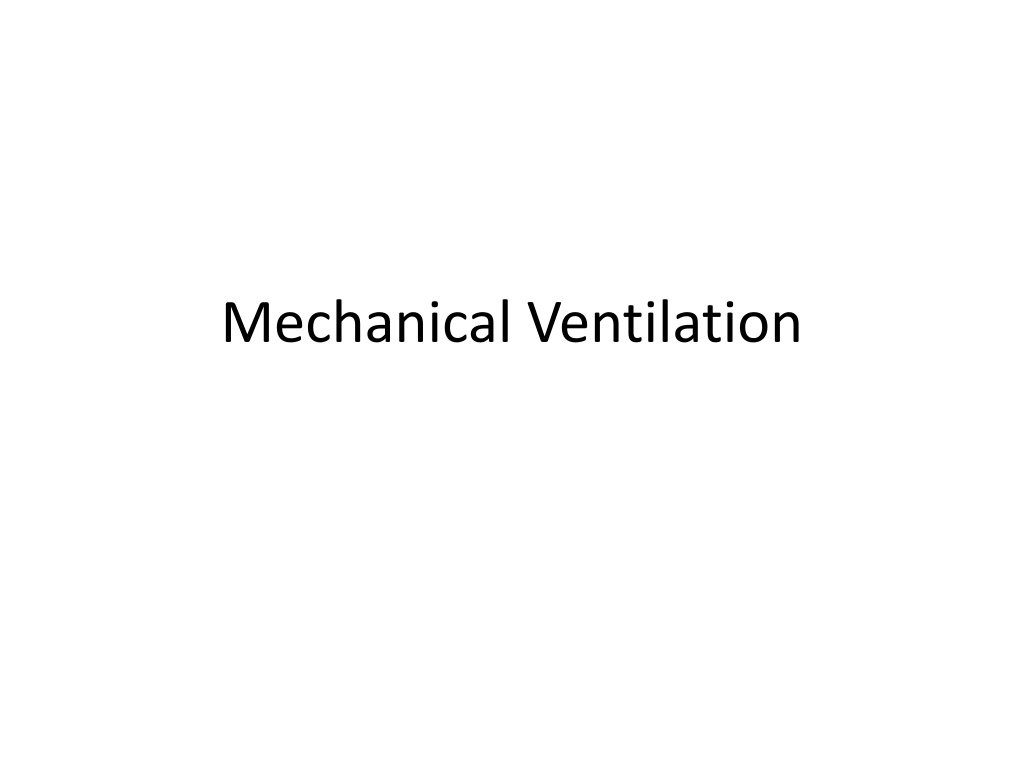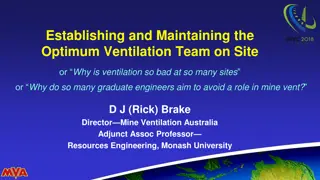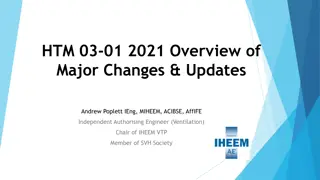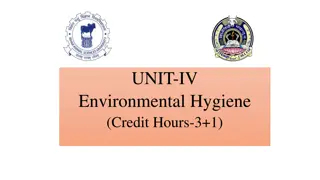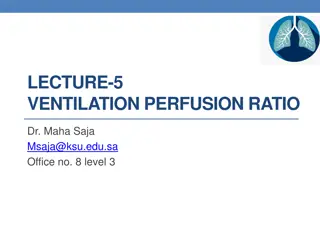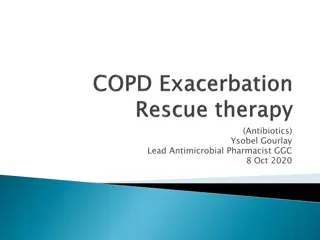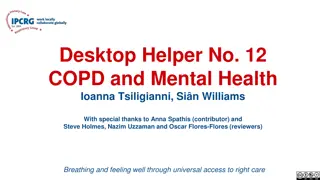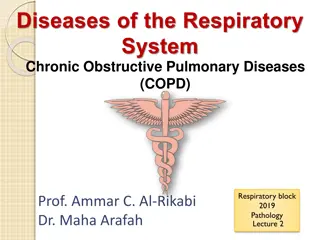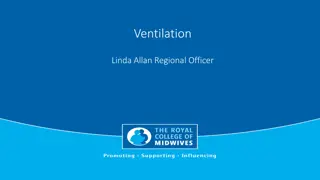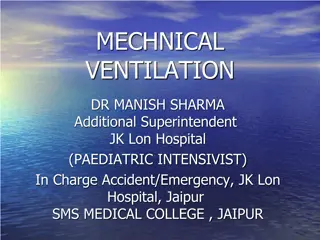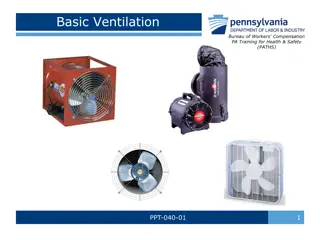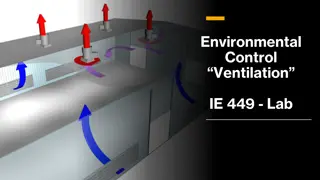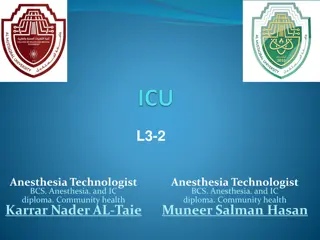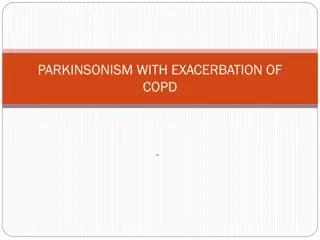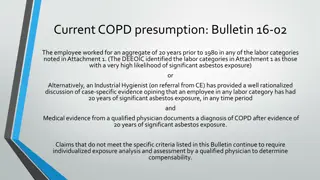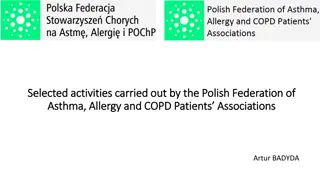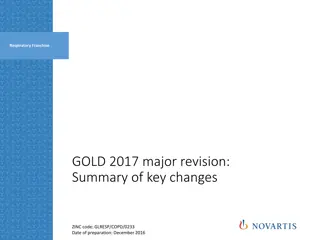Understanding Mechanical Ventilation in COPD Exacerbation
In a case of a 64-year-old woman with COPD exacerbation, managing respiratory distress is crucial. Initiating systemic corticosteroids, doxycycline, and nebulizers while closely monitoring the patient is important. However, in cases where non-invasive ventilation is ineffective, the patient may require intubation and mechanical ventilation. Understanding the goals and indications of mechanical ventilation, as well as recognizing and managing complications like increased intrathoracic pressure (auto-PEEP), is essential for optimal patient care.
Download Presentation

Please find below an Image/Link to download the presentation.
The content on the website is provided AS IS for your information and personal use only. It may not be sold, licensed, or shared on other websites without obtaining consent from the author. Download presentation by click this link. If you encounter any issues during the download, it is possible that the publisher has removed the file from their server.
E N D
Presentation Transcript
What would you do? You are called to the ED to see a 64 yo woman with COPD who appears to be here with a COPD exacerbation. PE: T 38 C, HR 110, RR 28, BP 110/70 moderate respiratory distress, accessory muscle use, decreased bilaterally with prolonged expiration CXR: hyperinflation, no consolidations ABG: 7.3/60/58, 88% on 2L NC
You choose to closely monitor her, start systemic corticosteroids, doxycycline, and nebs. Which of the following is MOST appropriate? A. Increase O2 & give continuous albuterol B. Continuous albuterol only C. Intubation & Mechanical Ventilation D. Noninvasive PPV (BiPAP)
Mechanical Ventilation Goals Relieve Respiratory Distress Decrease Work of Breathing Improve Gas Exchange Support respiration while other organs recover Do so while avoiding complications of PPV
Mechanical Ventilation Indications Hypoxemia Hypercarbia Coma or inability to protect airway Procedures Hemodynamic Instability (relative)
Case continued Eventually NIV was deemed ineffective and she is intubated. The tube passes easily and placement is confirmed with end-tidal CO2. She is initially bagged at a rate of 25 bpm. Immediately after intubation her BP drops (70/40).
Take a deep breath What is happening here? A. Sepsis B. Pneumothorax C. Increased intrathoracic pressure ( auto- PEEP ) D. Myocardial Infarction
After you stop freaking out What should you do next? A. Give more IV fluid B. Put a needle in the chest left anterior intercostal C. Stop bagging the patient and allow for exhalation D. Start norepinephrine
Complications of Intubation Inability to ventilate Inability in intubate Hypotension Aspiration Hypoxemia Arrhythmia Dislodge loose teeth Beware co-morbidities (PH, AS, obesity)
Complications of MV/PPV Barotrauma (aka Ventilator induced lung injury) Ventilator Associated Pneumonia Weakness with prolonged MV Tracheal Stenosis Trauma to airway Skin breakdown associated with tube and fasteners Need for Pain & Sedation Meds
Settings Positive pressure ventilation (PPV) is very simple Air is delivered to the patient under pressure You determine the amount (volume) or force (pressure) You determine the rate, you let the patient breath spontaneously, or you allow a combination. Finally, you determine the FiO2and PEEP
The BP improved What ventilator settings would be most appropriate for this 60 kg patient? A. VC, RR 22, TV 400mL, PEEP 5cm H2O, FiO21 B. VC, RR 12, TV 500mL, PEEP 5cm H2O, FiO20.6 C. VC, RR 20, TV 700mL, PEEP 5cm H2O, FiO20.6 D. PC, RR 15, PIP 25cm H2O, PEEP 5cm H2O, FiO21
Typical Ventilator Order Includes Mode Respiratory Rate Volume or Inspiratory Pressure FiO2or directions for titrating Positive end-expiratory pressure (PEEP) That s it. The RT programs the rest - I:E, flow rate (in VC), alarms, etc.
Variables Oxygenation FiO2 PEEP Mean Airway Pressure (Paw) Ventilation (CO2) RR Tidal Volume Peak inspiratory pressures (PIP) Pressure required to overcome resistance Plateau Pressures (PP) surrogate for Transpulmonary Pressures, measured at end-inspiration Compliance how stiff is the lung? Auto-PEEP (aka intrinsic PEEP) measured with end-expiratory hold maneuver
Wave Forms Insert typical wave for with labels to define each variable from the prior slide.
Back to you COPD patient You put the patient on volume control at a rate of 16 and a tidal volume of 600 mL. Which one statement is true of the tidal volume delivered if the measured rate is 22. A. 600 mL every breath B. 600 mL during the 16 set breaths, & pt triggered breaths determined by effort C. Tidal volume determined by pt efforts each breath D. Tidal volume depends on lung compliance
Modes Variable Volume Control Pressure Control Pressure Support Volume Same every breath Depends on pt effort and lung compliance Depends on pt effort and lung compliance Pressure Depends on lung compliance Same every breath Same every breath Rate Minimum set, but pt can trigger spontaneously Minimum set, but pt can trigger spontaneously Completely Spontaneous Flow rate Same every breath Depends on pt effort and lung compliance Depends on pt effort and lung compliance Waveforms Pressure-time Pressure-volume loop Volume-time Flow-time Volume-time
Wave Forms Video/graph of each wave form specific to each mode with anotations.
